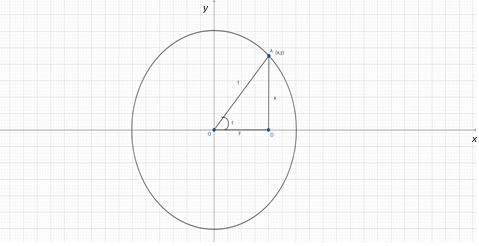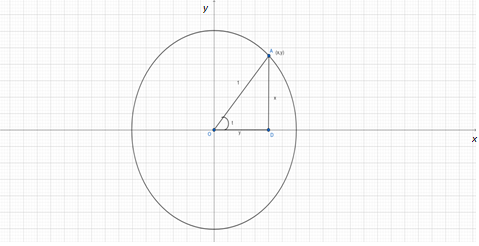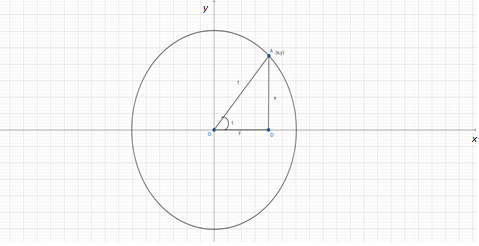
a.
To explain: Why Cosine means sine of the complement.
The sine of the complement is the cosine.
Given information:
The unit circle
Calculation:
If the sum of the angles is
Taking the cosine of an angle
Therefore, from the above equation it is shown that the sine of the complement is the cosine.
b.
To find: The coordinates of
The coordinates of
Given information:
The unit circle
Calculation:

Let’s take the point
Consider the right angle triangle ADO,
Using the cosine function,
Therefore, the coordinates of
c.
To find: The length BC as a function of
The length with respect to the function of t is
Given information:
The unit circle
Calculation:

Consider the triangle ODA and OCD,
From part (b) it is known that,
Substituting the values,
Therefore, the length with respect to the function of t is
d.
To find: The length OB as a function of
The length with respect to the function of t is
Given information:
The unit circle
Calculation:

Consider the triangle ODA and OCD,
From part (b) it is known that,
Substituting the values,
Therefore, the length with respect to the function of t is
e.
To explain: Where the names tangent, cotangent, secant and cosecant came from.
Given information:
The unit circle
Explanation:
A tangent is named after a Latin term that means "to touch." The tangent line touches the unit circle, hence the name.
Since a cotangent is the tangent of a complementary angle, its name is derived from this fact,
The word "secant" is derived from the Latin word "secare," which meaning "to cut," because a secant must intersect at least two separate locations.
Chapter 4 Solutions
PRECALCULUS:GRAPH...-NASTA ED.(FLORIDA)
- Calculus lll May I please have an explanation about how to calculate the derivative of the surface (the dS) on the surface integral, and then explain the essentials of the surface integral?arrow_forwardУ1 = e is a solution to the differential equation xy" — (x+1)y' + y = 0. Use reduction of order to find the solution y(x) corresponding to the initial data y(1) = 1, y′ (1) = 0. Then sin(y(2.89)) is -0.381 0.270 -0.401 0.456 0.952 0.981 -0.152 0.942arrow_forwardsolve pleasearrow_forward
- The parametric equations of the function are given asx=asin²0, y = acos). Calculate [Let: a=anumerical coefficient] dy d²y and dx dx2arrow_forwardA tank contains 200 gal of fresh water. A solution containing 4 lb/gal of soluble lawn fertilizer runs into the tank at the rate of 1 gal/min, and the mixture is pumped out of the tank at the rate of 5 gal/min. Find the maximum amount of fertilizer in the tank and the time required to reach the maximum. Find the time required to reach the maximum amount of fertilizer in the tank. t= min (Type an integer or decimal rounded to the nearest tenth as needed.)arrow_forwardThumbi Irrigation Scheme in Mzimba district is under threat of flooding. In order to mitigate against the problem, authorities have decided to construct a flood protection bund (Dyke). Figure 1 is a cross section of a 300m long proposed dyke; together with its foundation (key). Survey data for the proposed site of the dyke are presented in Table 1. Table 2 provides swelling and shrinkage factors for the fill material that has been proposed. The dyke dimensions that are given are for a compacted fill. (1) Assume you are in the design office, use both the Simpson Rule and Trapezoidal Rule to compute the total volume of earthworks required. (Assume both the dyke and the key will use the same material). (2) If you are a Contractor, how many days will it take to finish hauling the computed earthworks using 3 tippers of 12m³ each? Make appropriate assumptions. DIKE CROSS SECTION OGL KEY (FOUNDATION) 2m 1m 2m 8m Figure 1: Cross section of Dyke and its foundation 1.5m from highest OGL 0.5m…arrow_forward
- The parametric equations of the function are given as x = 3cos 0 - sin³0 and y = 3sin 0 - cos³0. dy d2y Calculate and dx dx².arrow_forward(10 points) Let f(x, y, z) = ze²²+y². Let E = {(x, y, z) | x² + y² ≤ 4,2 ≤ z ≤ 3}. Calculate the integral f(x, y, z) dv. Earrow_forward(12 points) Let E={(x, y, z)|x²+ y² + z² ≤ 4, x, y, z > 0}. (a) (4 points) Describe the region E using spherical coordinates, that is, find p, 0, and such that (x, y, z) (psin cos 0, psin sin 0, p cos) € E. (b) (8 points) Calculate the integral E xyz dV using spherical coordinates.arrow_forward
- (10 points) Let f(x, y, z) = ze²²+y². Let E = {(x, y, z) | x² + y² ≤ 4,2 ≤ z < 3}. Calculate the integral y, f(x, y, z) dV.arrow_forward(14 points) Let f: R3 R and T: R3. →R³ be defined by f(x, y, z) = ln(x²+ y²+2²), T(p, 0,4)=(psin cos 0, psin sin, pcos). (a) (4 points) Write out the composition g(p, 0, 4) = (foT)(p,, ) explicitly. Then calculate the gradient Vg directly, i.e. without using the chain rule. (b) (4 points) Calculate the gradient Vf(x, y, z) where (x, y, z) = T(p, 0,4). (c) (6 points) Calculate the derivative matrix DT(p, 0, p). Then use the Chain Rule to calculate Vg(r,0,4).arrow_forward(10 points) Let S be the upper hemisphere of the unit sphere x² + y²+2² = 1. Let F(x, y, z) = (x, y, z). Calculate the surface integral J F F-dS. Sarrow_forward
 Calculus: Early TranscendentalsCalculusISBN:9781285741550Author:James StewartPublisher:Cengage Learning
Calculus: Early TranscendentalsCalculusISBN:9781285741550Author:James StewartPublisher:Cengage Learning Thomas' Calculus (14th Edition)CalculusISBN:9780134438986Author:Joel R. Hass, Christopher E. Heil, Maurice D. WeirPublisher:PEARSON
Thomas' Calculus (14th Edition)CalculusISBN:9780134438986Author:Joel R. Hass, Christopher E. Heil, Maurice D. WeirPublisher:PEARSON Calculus: Early Transcendentals (3rd Edition)CalculusISBN:9780134763644Author:William L. Briggs, Lyle Cochran, Bernard Gillett, Eric SchulzPublisher:PEARSON
Calculus: Early Transcendentals (3rd Edition)CalculusISBN:9780134763644Author:William L. Briggs, Lyle Cochran, Bernard Gillett, Eric SchulzPublisher:PEARSON Calculus: Early TranscendentalsCalculusISBN:9781319050740Author:Jon Rogawski, Colin Adams, Robert FranzosaPublisher:W. H. Freeman
Calculus: Early TranscendentalsCalculusISBN:9781319050740Author:Jon Rogawski, Colin Adams, Robert FranzosaPublisher:W. H. Freeman
 Calculus: Early Transcendental FunctionsCalculusISBN:9781337552516Author:Ron Larson, Bruce H. EdwardsPublisher:Cengage Learning
Calculus: Early Transcendental FunctionsCalculusISBN:9781337552516Author:Ron Larson, Bruce H. EdwardsPublisher:Cengage Learning





